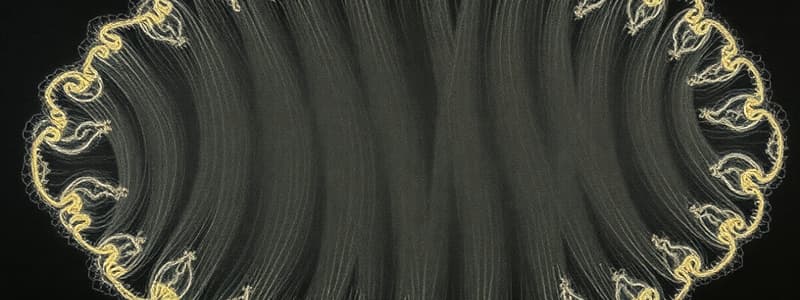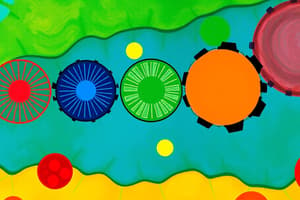Podcast
Questions and Answers
What does the cell cycle describe?
What does the cell cycle describe?
How a newly formed cell matures and replicates itself.
How many main stages does the cell cycle have?
How many main stages does the cell cycle have?
- 2
- 5
- 4
- 3 (correct)
Match the stage of the cell cycle with the description:
Match the stage of the cell cycle with the description:
Interphase = Cell growth and duplication of chromosomes Mitosis = Division of the nucleus Cytokinesis = Division of the cytoplasm
In which stage of the cell cycle does a cell live for most of its life?
In which stage of the cell cycle does a cell live for most of its life?
What main event occurs during the Synthesis (S) phase of interphase?
What main event occurs during the Synthesis (S) phase of interphase?
What occurs during the Growth 1 (G1) phase of interphase?
What occurs during the Growth 1 (G1) phase of interphase?
What do chromosomes carry?
What do chromosomes carry?
Human somatic cells will have 4 copies of every chromosome.
Human somatic cells will have 4 copies of every chromosome.
How many chromosomes do human cells contain in total?
How many chromosomes do human cells contain in total?
After a chromosome has been duplicated, what is it made of?
After a chromosome has been duplicated, what is it made of?
What happens to sister chromatids during mitosis?
What happens to sister chromatids during mitosis?
What is the second stage of the eukaryotic cell cycle?
What is the second stage of the eukaryotic cell cycle?
Daughter cells are genetically different from each other after mitosis.
Daughter cells are genetically different from each other after mitosis.
If a cell is damaged and cannot be repaired, what might happen?
If a cell is damaged and cannot be repaired, what might happen?
What can uncontrolled cell division result in?
What can uncontrolled cell division result in?
Flashcards
Cell Cycle
Cell Cycle
Describes how a newly formed cell matures and replicates.
Interphase
Interphase
The period of the cell cycle where the cell grows and duplicates its chromosomes.
Mitosis
Mitosis
Division of the nucleus.
Cytokinesis
Cytokinesis
Signup and view all the flashcards
Interphase: Growth 1 (G1)
Interphase: Growth 1 (G1)
Signup and view all the flashcards
Interphase: Synthesis (S)
Interphase: Synthesis (S)
Signup and view all the flashcards
Interphase: Growth 2 (G2)
Interphase: Growth 2 (G2)
Signup and view all the flashcards
Chromosome
Chromosome
Signup and view all the flashcards
Diploid
Diploid
Signup and view all the flashcards
Sister Chromatids
Sister Chromatids
Signup and view all the flashcards
Mitosis
Mitosis
Signup and view all the flashcards
Cell Cycle Checkpoints
Cell Cycle Checkpoints
Signup and view all the flashcards
Apoptosis
Apoptosis
Signup and view all the flashcards
Prophase
Prophase
Signup and view all the flashcards
Metaphase
Metaphase
Signup and view all the flashcards
Anaphase
Anaphase
Signup and view all the flashcards
Telophase
Telophase
Signup and view all the flashcards
Study Notes
- The eukaryotic cell cycle consists of sub-phases of mitosis and cytokinesis in plant and animal cells.
- The cell cycle is how a newly formed cell matures and replicates.
- The three main stages of the cell cycle include interphase, mitosis, and cytokinesis.
Interphase
- Interphase involves cell growth and duplication of chromosomes.
- Cells spend most of their lives in interphase.
- Interphase is separated into three phases: G1, S, and G2.
- The cell grows and increases in volume during Growth 1 (G1).
- Organelles are replicated and prepares for DNA replication during G1.
- The cell replicates its DNA/chromosomes during Synthesis (S).
- Cell growth occurs and the cell prepares for mitosis during Growth 2 (G2).
DNA and Chromosomes
- A chromosome consists of DNA tightly wrapped around proteins
- Chromosomes carry the genetic information (genes) of a cell.
- Human somatic cells are diploid (2n), containing two copies of every chromosome from each parent.
- Human cells have 23 pairs or 46 total chromosomes.
- A duplicated chromosome consists of two "sister chromatids".
- Sister chromatids separate during mitosis.
Mitosis and Cytokinesis
- Mitosis comes second in the cell cycle.
- Mitosis results in exact and equal amounts of nuclear DNA in each daughter cell.
- Daughter cells are genetically identical.
- Mitosis has several stages: Prophase, Metaphase, Anaphase, and Telophase (P → M → A → T).
- Cytokinesis follows mitosis.
Regulation
- The cell cycle has checkpoints to check for errors for the next stages.
- The cell cycle halts for repairs if a cell is damaged or not ready.
- Apoptosis, or programmed cell death, may occur if the damage cannot be repaired.
- G1, G2, and M checkpoints exist.
- Uncontrolled cell division from malfunctions can result in tumor or cancer formation.
Studying That Suits You
Use AI to generate personalized quizzes and flashcards to suit your learning preferences.



